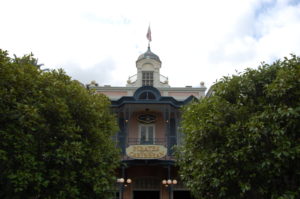The problem when you only want to use IP, is that you really start to narrow the scope of your offerings and everything starts becoming a bit homogenized. How many nighttime spectaculars can you have that feature the same dozen or two films? The same ones that all the rides you went on were based on, and the shows, and the food, and shops, and merchandise, and supplementary experiences, etc.
Don’t get me wrong I think the use of IP can be great, and Disney – for example – certainly has a lot of good ones. But still a family visiting the resort for the week in the world of a nonstop barrage of princesses and Pixar is going to be overloaded. And the target audience becomes smaller as well – only people who want to be overloaded with Mickey and friends. The beauty of WDW as it was for a long time, and still a bit to this day is the breadth of what is offered. Each park gives a different experience, a different tone, etc. Unique one of a kind of experiences like Hoop Dee Doo, La Nouba, the Safari, World Showcase, etc all are products worthy of a Disney name – but they’re Disney because they’re family oriented and they’re quality, not because they fit in with a tightly vertically integrated set of brands.
And this IP issue applies to all parks, not just Disney. Why limit yourself to a narrow catalog of flavors that have been hashed and rehashed and arguably no one wants in the first place? You risk turning your parks from interesting one of a kind experiences into just another manifestation of the toy section at Walmart.
It’s really a push to commoditize – to turn everything into a franchise; and frankly theme parks have historically served to get us away from the mass francisization of the rest of our world – places full of unique individuality. Instead, today they’re becoming prime examples of that process – shopping malls mercilessly cut into distinct marketing verticals.
There’s room for some of this to happen, room for a lot of it to happen without ruining what is there – but that room isn’t endless and the trends are worrying. Theme parks, like any form of art, need to be able to stand on their own, not just be an elaborate merchandising and advertising branch of their parent company. People can sense that and sure they’ll visit because they’re interested- but people visit World of Coke or the Hershey Factory once or twice. They don’t form emotional bonds with them – and if you want your guests to keep coming back – like the current crop of guests you’re relying on – you need to create those emotional bonds which means you need to create something that actually says and means something and isn’t hollow. That’s why the current crop of guests is so loyal – because of the decades of attachment and experiences that have preceded.
And furthermore for theme parks to be successful,memorable, impactful – they need to be cohesive, they need to have a point of view, they need to have themes in the narrative sense – not in the Birthday party sense. Otherwise they’re forgettable and trivial. This is obvious to anyone who has been to a castle park, Animal Kingdom, old Epcot, Disney Sea, and even Islands Of Adventure to a degree. And yet it’s continually ignored by people in charge.
Anyway this rant has gone on long enough – and I am optimistic, the people at the top might not have their priorities in great places but the people in creative positions do. The people that work at Pixar and Disney animation have worked out a nice balance of being able to tell great meaningful stories while still balancing the needs of the corporate overlords and that leaves me hopeful that the same can happen in the theme park world as well. And I’ll be the first to admit there’s a lot of underutilized IP that should have been turned into attractions ages ago – what we see these days is in no small part a reaction to that. And maybe one day, almost certainly one day, new unique experiences will again be a priority – breadth, variety, and novelty will be the new vertical integration as business strategies constantly shift. But at any rate it’s still frustrating, and worrying, and we’ll just have to see what happens.



